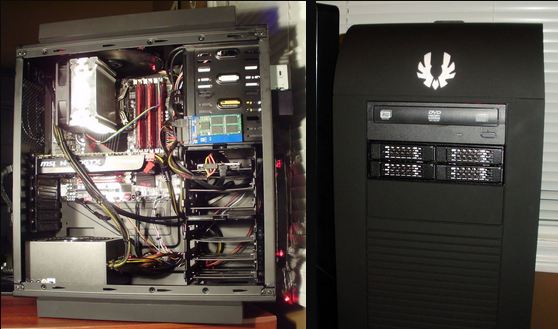TEST BENCH CONFIGURATION
| Motherboard | Asus Rampage III Gene SATA 6Gb/s USB3 |
| CPU | Intel i7-930 CPU@2.80Ghz (OC’d to 3.2Ghz) |
| RAM | 6Gb G.Skill 1600 Triple Channel |
| Graphics | MSI N460GTX DDR5 768MB |
| Power Supply | OCZ ModXStream-Pro 600w |
| CPU Cooler | Cooler Master Hyper 212+ |
| OS | Windows 7 64 Bit Ultimate |
| Wifi | Belkin Surf & Share Wireless USB Adapter |
| Monitor | Dell E228WFP 22″ Flat Panel |
| Desktop Case | BitFenix Survivor Mid-Tower ATX Gaming Case (x) |
| Front Loading Mobile SSD Rack | Icy Dock SSD 4 x 2.5″ Mobile Rack (x) |
SOFTWARE

Software used for testing by The SSD Review consists of Crystal Disk Mark, HDTune Pro, ATTO Benchmark, HDTach, along with FutureMark PCMark Vantage. The first four do a great job of showing us the numbers that we want to see, or don’t want to see in some cases, while PCMark Vantage x64 is an excellent program which recreates tests that mimic the average users activity, all the while providing a medium to measure each.
All tests are conducted in Windows 7 safe mode, wherever possible, as this gives the truest result for evaluation purposes; the sole exception being PCMark Vantage which would not function in safe mode. Where the opportunity exists, tests are repeated to ensure accuracy and consistency of results.
We also like to provide a bit of background to the reader that all SSDs are not created equal and this can have a confusing impression to users that are not aware of the intricacies of testing their SSD. SandForce SSDs utilize compression techniques in storage whereas many others do not. This presents a false portrayal of their ability when testing a SandForce SSD with software such as Crystal DiskMark-Random Data Mode or AS SSD. A comparison of a Samsung, Crucial or Intel to the SandForce will result in the SandForce appearing to have inferior performance scores whereas, Vantage tells the true tale of the tape. This is why we stick to Vantage for our SSD comparison testing. Read on though because we just might throw a real life test in for this review.
BENCHMARKS
1. Crystal DiskMark 3.0
We were particularly impressed with the 4k random write score being very high at 71MB/s in this test simply because this is the most important disk access method considered when speaking of visible performance difference. This is an ideal score with both high sequential reads and writes coming close to the SATA 2 limit.
2. ATTO Disk Benchmark Ver. 2.46
The ATTO Bench pushes performance to the limit with a read performance maximum of 285MB/s and a write of 275MB/s, a score we haven’t seen bettered in SATA 2. Of interest to readers is the fact that this performance test method is the most commonly used by manufacturers simply because numbers sell. Very few people will ever use high sequential disk access in their every day activities yet they will jump to buy the SSD that boasts of these incredible speeds. The educated consumer is digging a little deeper and finding the smaller 4k random score that we explained above because they know that their every day computer activity utilizes this access method in over 50% of its disk access. This is where you will feel the beauty of the SSD through performance.
3. HDTach Ver. 3.0.4.0
Although not pushing the limits that ATTO has, HDTach does a nice job of displaying exactly how comfortable this drive is with the job. We like to see smooth charting as with this test as it indicates that there is no interference from the OS or outside applications in the testing..
 The SSD Review The Worlds Dedicated SSD Education and Review Resource |
The SSD Review The Worlds Dedicated SSD Education and Review Resource | 
